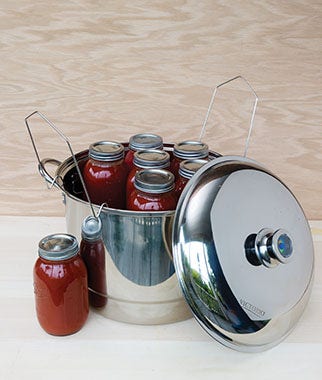We use cookies to give you the best experience on our website. These cookies are completely safe and secure and will never contain any sensitive information. Please read our Privacy Policy. By clicking "Ok" or clicking on any other content, you agree that cookies can be placed.
Canning Basics
The growing season rewards us with delicious, fresh and healthy fruits and vegetables. One of the best ways to extend the enjoyment of the tastiest produce into the winter months is to can.
Canning may seem like complex art form. But if you follow certain steps, you can safely preserve many things like tomatoes, jams, jellies and pickles, in a manner that the flavor and nutrition are intact. If you're concerned about doing it correctly and safely, it's comforting to know that your jars will tell you that you've done it right. They will tell you with a ping or a pop as they cool. That sound is a joyful noise in canning.
"The sign that you've succeeded is so clear," said Daniel Gasteiger, author of Yes, You Can! And Freeze and Dry It, Too. The Modern Step by Step guide to Preserving Food, speaking of the pop that's created as the canning lid safely seals. Here's the basic process.
Say you love salsa made from your homegrown tomatoes and cilantro. If you want to have that luxury in the midst of winter, prepare salsa with a time-tested canning recipe. Take some simple steps to sterilize canning jars and lids. Add the salsa to the jars, leaving the proper amount of space at the top of the jar, put lids on, put the full jars in a large pot with enough water to cover the jars, and boil for the required time. Easy as that, you're canning.
While it's simple, there are important guidelines and you must use approved canning recipes to make sure your preserves will be safe. But if you can follow directions, you can can. It really isn't difficult. Gasteiger suggests starting with high-acid canning.
The US Department of Agriculture divides canning into two types; high-acid and low-acid. High-acid includes all fruits. Low-acid canning is the preservation of vegetables and meats. High-acid canning also includes preservation of food that has had extra acid added to it, like pickles, tomatoes or chutneys. Acid can be added in the form of vinegars, citric acid or lemon juice.
Other than the type of food involved, the main difference between the two types of canning is temperature. The acid levels in high-acid canning kill many micro-organisms that can be harmful. Canning in a boiling water bath at 212 degrees is sufficient to preserve high-acid foods safely. Low-acid food must be heated to 240 degrees in a pressure canner to ensure the food will keep fresh over time. Canning recipes will provide exact times for heating. Boiling times also change based on your elevation. For example, home canners at higher elevations will need to boil the full jars longer.
Tomatoes are fruit and many of them would be considered high-acid. But some are not. So for safety, the USDA says to add acid to tomatoes. There are tested tomato canning recipes that take the guess work out for you. Make sure to carefully follow recipes because the ratio of acid to vegetable is important. The USDA has pdf's that you can download as a starting place.
"The easiest mistake to make is failing to follow a USDA recipe," said Gasteiger, " Make sure the proportions are correct when adding acid and salt. It's always safe to add more acid."
As with deciding what to grow in your vegetable garden, Gasteiger says to carefully look at what you eat when deciding what to can.
"Really focus on what you love to eat. If you don't eat the stuff, why bother?" he asks, "Pickle lovers may want to start there. People who love jams and jellies should begin there."
Gasteiger warns against being intimidated by canning based on equipment needed. Except for a jar lifter, he canned for 12 years before he purchased any special canning tools. If you have a pot that is an inch and a half taller than the tallest jar you want to can, some tongs, a chopstick, and a canning jar lifter, you can give it a whirl. You need tongs sterilized by boiling to lift the lids onto the jars after they are filled. A chopstick is used release bubbles after you've placed the food in the jars before placing the lids.
"I'd hate to can without a jar lifter," said Gasteiger, "Lifters are like giant pliers that you can use to place the jars into the boiling water bath and remove them from the water bath once they are done."
After the jars are removed from the boiling water bath, allow them to cool to room temperature.
"In about ten minutes, each jar seals," said Gasteiger, "when the metal lid bends down, you hear a pop or ping. That means you've done it right."

